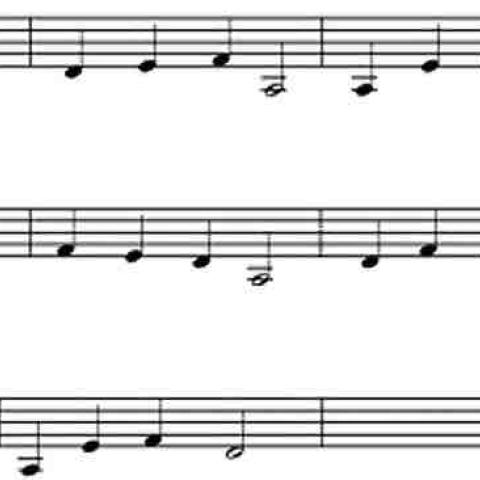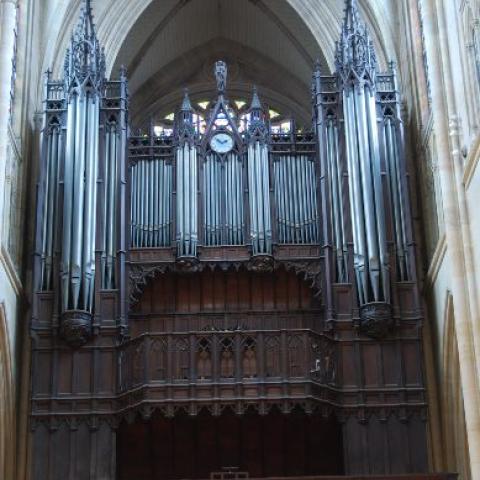Jonathan Hehn, OSL, is a musician and liturgist currently serving University of Notre Dame in Notre Dame, Indiana. He is a brother in the Order of Saint Luke, a religious order committed to sacramental renewal and liturgical scholarship, and holds degrees in music from Florida State University (Bachelor of Music, Doctor of Music), Tallahassee, Florida, and theology from University of Notre Dame (Master of Sacred Music, Master of Arts). A passionate practitioner, writer, and thinker, one can find him on Facebook, Twitter, and Instagram @JonathanHehn.

Jean Langlais (1907–1991) was one of the best-known organist-composers of the twentieth century. He rightfully holds a place of prominence in the French school alongside his contemporary and friend, Olivier Messiaen. Langlais, who was blind from the age of two, studied organ first under André Marchal at the Institut National des Jeunes Aveugles (National Institute for Blind Children). Later, in the early 1930s, he studied organ with Marcel Dupré and composition with Paul Dukas at the Paris Conservatory.
By 1945 he had been appointed titular organist of the Basilica of Sainte Clotilde in Paris, where he stood in the line of Charles Tournemire and César Franck. Over the course of his lifetime, he performed more than three hundred concerts in the United States and became world renowned as a teacher, especially of the art of improvisation. His published works for organ are numerous, often based on Gregorian chants or hymn tunes.
The suite Cinq Méditations sur l’Apocalypse is an excellent example of the composer’s mature style. It was first published in 1974, and Langlais attested that it was conceived over a more than thirty-year period. Thus this suite represents compositional skills accumulated over a lifetime. It is far more esoteric than some of his other works, even those of the same period. Marie-Louise Jaquet-Langlais has pointed out that, because Cinq Méditations was not a commissioned work, the composer was able to compose it freely, without limits on style, length, or subject matter.1
Because of the immensity and density of Cinq Méditations, it took me several years to find an opportune time to perform the work in its entirety in a single sitting. I was fortunate to finally be able to do so on All Saints Day, November 1, 2020, in the Basilica of the Sacred Heart on the campus of the University of Notre Dame. The preparation process was intentionally long and careful, and as I prepared each movement, I made note of many instances of errata in the published score, available from Alphonse Leduc/Editions Bornemann. With a work this size, there are bound to be editing errors, and indeed that is the case here. I present here a list of errata in a lightly annotated fashion, along with some simple program notes. My hope, as future organists continue to discover this masterpiece of organ literature, is that those who seek to learn Cinq Méditations can take advantage of that list in their preparations, in order to present the intentions of the composer as accurately as possible.
More than a little gratitude is due to my colleagues Dr. Beverly Howard, professor emerita of music at California Baptist University, and Dr. Marshall Jones, adjunct professor at Flathead Valley Community College and music director at Bethlehem Lutheran Church, Kalispell, Montana. Both are music theorists and organists who offered invaluable advice on some of the more ambiguous spots I address in the score, and who provided clarifying language in many instances.
Performing notes
The overall organizing principle for Cinq Méditations is textual more than it is musical. That is, the movements are each musical reflections on a verse or passage from the Book of Revelation, sometimes referred to in both French and English as the “Apocalypse of John.” Langlais reportedly read the Book of Revelation many times, and the profundity of this suite reflects both his deep understanding of and also deep respect for Saint John’s epistle. Langlais also had a timely reason for finishing the composition of a work pondering the end times; in 1973, just one year prior to the suite’s publication, he suffered a severe heart attack that almost killed him. As Mme. Langlais has also said, this may have proved the impetus for Jean finally completing this long-gestated work.
As with much of the organ music of Messiaen, works by Langlais are often meant to be heard in a church replete with visual splendor, intentional architecture, and a substantial acoustic. In the slower movements, Langlais’ music often moves at an incredibly slow pace, a tool that both he and other composers have used to evoke a sense of eternity. When performing this piece in concert, I often encourage listeners to let their eyes wander and peruse the visual offerings of the space in which they find themselves while listening. Gothic and Gothic revival architecture is particularly appropriate to this exercise, since the design of such spaces is meant to draw the eye upward throughout the room, as if transporting its observers into the eternity of heaven. Allowing one’s gaze to wander upward while listening to pieces such as Langlais’ Cinq Méditations can make clear the natural affinity between the form of this music and the form of the building.
At other times, in both slow and fast sections, Langlais inserts long moments of silence between musical phrases. In so doing, he exploits the acoustics of the room by allowing the sound to slowly dissipate into its far reaches, and the mind of the listener to absorb what has just been heard. Again, live performances given in an appropriate space make clear certain aspects of the work that are not fully graspable when listening to recordings or in a concert hall.
Errata and notes for individual movements
Because the published score does not contain measure numbers, the locations of each error will be noted as page (p.#), system (s.#), measure (m.#), and beat (b.#). Erratum 1 in the following list, for example, is listed as “p. 3, s. 1, m. 1, b. 4,” meaning page 3, system 1, measure 1 of that system, beat 4 of that measure. Where there is no fixed meter, the beat numbers are omitted.
I. Celui qui a des oreilles, qu’il Оcoute (He that has ears, let him hear)
A fugue with a wide-ranging subject, this introductory movement features a recurring statement of the fourth Gregorian psalm tone by the pedal. Each statement of the psalm tone presents a different number of syllables, suggesting that this movement was based on a particular chanted text, though Langlais gives no clue as to what that text might be.
• Example 1: p. 3, s. 1, m. 1, b. 4: the stem is missing in the bass voice G-sharp. It should be a quarter note.
• Example 2: p. 3, s. 2, m. 1, b. 1: there is a missing beam in the bass voice. There should be two eighth notes.
II. Il Оtait, Il est, et Il vient (He is, He was, and He is to come)
This movement is divided into five large sections. The first, third, and fifth sections each feature a constant high drone on the note F, perhaps symbolizing the unity and eternity of Christ, underneath which curling, syncopated motives explore various harmonic intervals against the drone. The second and fourth sections each present a different Gregorian chant related to the incarnation. First, there is “Vexilla Regis Prodeunt,” a hymn of triumph of the Cross: “The Banners of the King issue forth, the mystery of the Cross does gleam, where the Creator of flesh, in the flesh, from the cross-bar is hung.” Then, in the fourth section, there is “Lauda Sion,” the Sequence hymn for Feast of Corpus Christi: “Sion, lift up your voice and sing: Praise your Savior and your King, Praise with hymns your shepherd true.”
• Example 3: p. 5, s. 3, m. 2: “Nazard” should read “ – Nazard,” to indicate taking that stop off. The Nazard has already been drawn in the Positif from the beginning of the movement.
• Example 4: p. 5, s. 2, m. 2, b. 3: Pedal G-natural should be A-natural, since in all other places, the pedal doubles the left hand at the octave.
• Example 5a: p. 6, s. 4, m. 2, b. 3: in the right hand, bottom voice, the second D should be D-flat. If a new edition were made, one might also change the C-sharps in system 3, measures 3–4 to D-flats for consistency and also for voice-leading considerations (Example 5b).
(p. 6, s. 4, m. 2, b. 3)
(p. 6, s. 3, m. 3)
• Example 6: p. 6, s. 4, m. 3, b. 1: in the right hand, middle voice, A-flat should be A-natural to match preceding examples.
• Example 7: p. 7, s. 3, m. 2, b. 2: the right hand is marked as a quarter note but should be an eighth note to accommodate the eighth rest immediately following. The flag is simply missing from the notehead.
• Example 8: p. 10, s. 3, m. 5: the left-hand middle voice, G in the final quarter note should probably be A-flat, because of the presence of the tie and given what is happening in the measures around it.
• Example 9: p. 10, s. 4, m. 1: ties are missing in the left hand at the beginning of the measure. They should have carried over from the previous system.
• Example 10: p. 10, s. 4, m. 2: the last chord is missing staccato marks in both hands. Also, the staccato markings are inconsistently applied in the previous two measures.
• Example 11: p. 10, s. 4, mm. 2–3: possible missing ties in the bottom two voices of the left hand between these two measures.
• Example 12: p. 13, s. 3, m. 2: the last note of the right hand (D-flat) should tie to the pedal C-sharp in the next measure. (cf. all other analogous passages in pp. 14–15).
• Example 13: p. 16, s. 1, m. 5: a slur is missing between the right-hand E-flat and pedal E-natural in the next measure. Even though it is not a common tone as in previous analogous spots, the dangling slur in the pedal makes it clear that it should connect from the right hand in the previous measure.
III. Visions prophetiques (Prophetic visions)
“Visions prophetiques” is the only movement of the suite whose title is not a direct quote from Revelation. It is a sort of bombastic scherzo; an initial section played on full organ registration is repeated later after each of several contrasting sections. Because of its clear form and the range of styles present in this single movement, I have often played it as a standalone piece.
• Example 14: p. 17, s. 1, m. 2: the left-hand part is missing three quarter-note rests.
• Example 15: p 19, s. 2, m. 5: top staff, top voice, last D-natural should be a D-flat. Voice leading suggests all parts should have moved down by a whole step (also cf. the first chord in that measure).
• Example 16: p. 21, s. 1, mm. 1–2: no pedal registration has been indicated for this section, so the indication to add the 4′ flute does not make sense. The texture here and the previous instruction at m. 28 suggest that this section should begin with 16′ and 8′ flutes as well as the Positif to Pédale coupler, adding the 4′ flute as indicated at this transition point.
• Example 17: p. 23, s. 2, m. 3: B in the first left-hand chord is erroneously marked as sharp. It should be A-sharp and B-natural as in preceding measure.
IV. Oh oui, viens, Seigneur Jésus (Even so, come, Lord Jesus)
It is odd that Langlais would choose to place this movement fourth in the suite rather than last, since “Oh oui, viens, Seigneur Jésus” is based on the final verse of the book of Revelation. Through his use of slow tempos, simple textures, and pensive melodies, he is here clearly exploring concepts of eternity, in a way reminiscent of Messiaen’s Le banquet céleste.
• Example 18: p. 24, s. 2, mm. 2–3: there should be a breath mark between measures 2 and 3 (cf. the corresponding passage at the top of p. 26).
• Example 19: p. 24, s. 4, m. 3: Sharps are missing from both pedal notes (cf. p. 26, s. 1, mm. 3–4).
• Example 20: p. 25, s. 4, m. 3: registration indications refer to Positif, not Récit. Also, the indication about which manual to play on is missing. Both hands should be on the Récit as at the beginning.
• Example 21: p. 26, s. 1, m. 3: middle C in the left hand should be C-sharp. The note to which it is tied in the next measure is sharp, and there is also an analogous spot with the C-sharp on p. 24, system 2.
• Example 22: p. 26, s. 2, mm. 2–3: it is possible that a tie is missing between the two A-flats in measures 2 and 3 of this system. This could also just be assumed because of the practice of tying common notes in much of the French repertoire.
V. La cinquième trompette (The fifth trumpet)
The final movement of Cinq Méditations brings to bear the full range of Langlais’ compositional techniques. Besides that, it is the movement perhaps most visually evocative of the readings on which it is based. This movement was the one that initially sparked my interest in the Cinq Meditations. Listen for Langlais’ clear imitation of the fifth trumpet (mentioned in the reading) and the “song” of the locusts, presented similarly to Messiaen’s quotations of bird song. The movement, and the suite as a whole, ends in a glorious and yet also terrifying toccata.
• Example 23: p. 27, s. 3, m. 6: a half rest is missing from the top staff.
• Example 24: p. 29, s. 4, m. 1: the right-hand sextuplet marks are missing but can be inferred from left-hand underlay in m. 49 and from markings present at the top of p. 30. There are similar instances of missing sextuplet markings on systems 1 and 2 of p. 29, but these are less consequential since there is a one-voice texture at each of those points.
• Example 25: p. 30, s. 3, m. 1: a tempo change is called for but is missing from the score. It should return to “Allegro” (100 beats per minute) as at p. 27, s. 2.
• Example 26: p. 30 s. 4, m. 1: the right hand should be played on the Récit (cf. p. 28 and other places).
• Example 27: p. 31, s. 1, m. 1 and following: “8va” marking is missing an end point. It would make the most sense if the bracket ended with the middle C-sharp in m. 71. It looks as if that may have been the intent but the registration instructions interfered with the layout in the engraving process.
• Example 28: p. 34, s. 2, m. 3: the right-hand lower voice should be G-natural both times to be consistent with analogous spots. This also gives consistency to the parallel tritone movement, prevalent throughout this section.
• Example 29: p. 34, s. 3, m. 3: the right hand is missing dots on the whole-note chord, which should match the left hand.
• Example 30: p. 34, s. 4, m. 3: the metronome marking is incorrect. Quarter note = 104 is impossible to play, and should be eighth note = 104.
• Example 31: p. 35, s. 1, m. 2: First five notes of the right hand should be beamed together as in the
following beats.
• Example 32: p. 36, s. 1, m. 1: the left-hand bottom voice should be E-natural (see the tie in preceding bar and cf. p. 26, s. 4, m. 3).
• Example 33: p. 37, s. 1, m. 1: the high F-sharp in the right hand should be D-sharp as in all other
surrounding measures.
• Example 34: p. 41, s. 2, m. 2: the right-hand low A-natural is missing a courtesy accidental, since the A is already flat in the left hand, b.1.
• Example 35: p. 41, s. 2, m. 3: there is a wrong number of beats in left-hand and pedal rests at beginning of the measure. There should be a sixteenth followed by a dotted sixteenth to match the right-hand rhythm.
Notes
1. Liner notes by Marie-Louise Langlais, translated by Roger Greaves, for the compact disc Suite Médiévale/Cinq Méditations sur l’Apocalypse, by Jean Langlais, Bruno Matthieu (organist), Naxos Records 8.553190, 1996, p. 3.
Cinq Méditations sur l’Apocalypse, by Jean-François Langlais. Copyright (c) 1974 by Alphonse Leduc Editions Musicales. International Copyright Secured. All Rights Reserved. Reprinted by permission of Hal Leonard, LLC.






